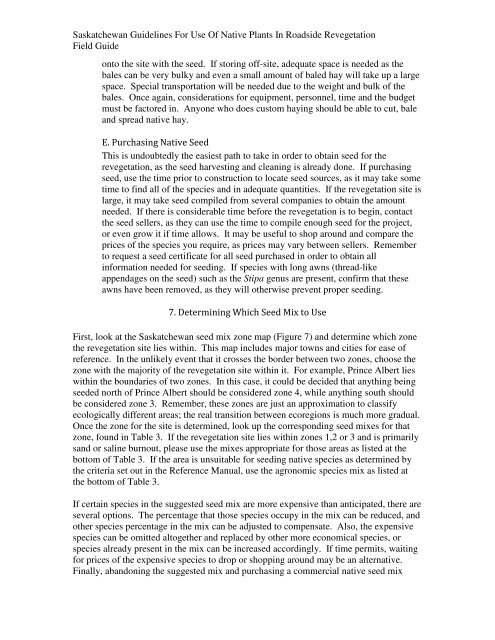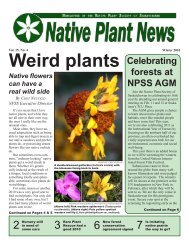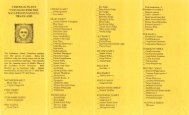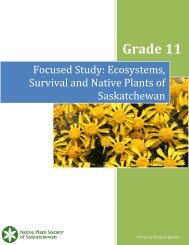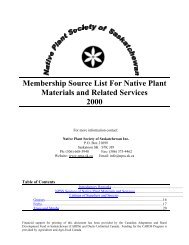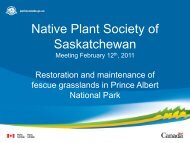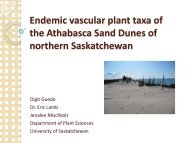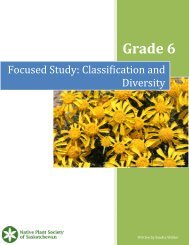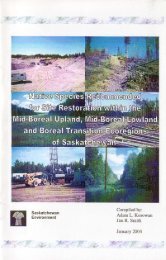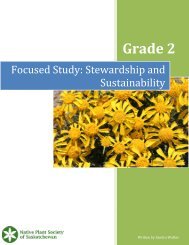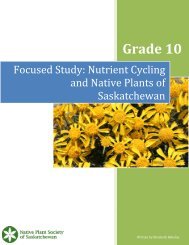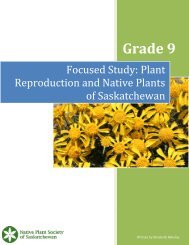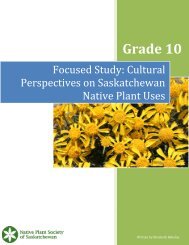Saskatchewan Guidelines For Use Of Native Plants In Roadside ...
Saskatchewan Guidelines For Use Of Native Plants In Roadside ...
Saskatchewan Guidelines For Use Of Native Plants In Roadside ...
Create successful ePaper yourself
Turn your PDF publications into a flip-book with our unique Google optimized e-Paper software.
<strong>Saskatchewan</strong> <strong>Guidelines</strong> <strong>For</strong> <strong>Use</strong> <strong>Of</strong> <strong>Native</strong> <strong>Plants</strong> <strong>In</strong> <strong>Roadside</strong> Revegetation<br />
Field Guide<br />
onto the site with the seed. If storing off-site, adequate space is needed as the<br />
bales can be very bulky and even a small amount of baled hay will take up a large<br />
space. Special transportation will be needed due to the weight and bulk of the<br />
bales. Once again, considerations for equipment, personnel, time and the budget<br />
must be factored in. Anyone who does custom haying should be able to cut, bale<br />
and spread native hay.<br />
E. Purchasing <strong>Native</strong> Seed<br />
This is undoubtedly the easiest path to take in order to obtain seed for the<br />
revegetation, as the seed harvesting and cleaning is already done. If purchasing<br />
seed, use the time prior to construction to locate seed sources, as it may take some<br />
time to find all of the species and in adequate quantities. If the revegetation site is<br />
large, it may take seed compiled from several companies to obtain the amount<br />
needed. If there is considerable time before the revegetation is to begin, contact<br />
the seed sellers, as they can use the time to compile enough seed for the project,<br />
or even grow it if time allows. It may be useful to shop around and compare the<br />
prices of the species you require, as prices may vary between sellers. Remember<br />
to request a seed certificate for all seed purchased in order to obtain all<br />
information needed for seeding. If species with long awns (thread-like<br />
appendages on the seed) such as the Stipa genus are present, confirm that these<br />
awns have been removed, as they will otherwise prevent proper seeding.<br />
7. Determining Which Seed Mix to <strong>Use</strong><br />
First, look at the <strong>Saskatchewan</strong> seed mix zone map (Figure 7) and determine which zone<br />
the revegetation site lies within. This map includes major towns and cities for ease of<br />
reference. <strong>In</strong> the unlikely event that it crosses the border between two zones, choose the<br />
zone with the majority of the revegetation site within it. <strong>For</strong> example, Prince Albert lies<br />
within the boundaries of two zones. <strong>In</strong> this case, it could be decided that anything being<br />
seeded north of Prince Albert should be considered zone 4, while anything south should<br />
be considered zone 3. Remember, these zones are just an approximation to classify<br />
ecologically different areas; the real transition between ecoregions is much more gradual.<br />
Once the zone for the site is determined, look up the corresponding seed mixes for that<br />
zone, found in Table 3. If the revegetation site lies within zones 1,2 or 3 and is primarily<br />
sand or saline burnout, please use the mixes appropriate for those areas as listed at the<br />
bottom of Table 3. If the area is unsuitable for seeding native species as determined by<br />
the criteria set out in the Reference Manual, use the agronomic species mix as listed at<br />
the bottom of Table 3.<br />
If certain species in the suggested seed mix are more expensive than anticipated, there are<br />
several options. The percentage that those species occupy in the mix can be reduced, and<br />
other species percentage in the mix can be adjusted to compensate. Also, the expensive<br />
species can be omitted altogether and replaced by other more economical species, or<br />
species already present in the mix can be increased accordingly. If time permits, waiting<br />
for prices of the expensive species to drop or shopping around may be an alternative.<br />
Finally, abandoning the suggested mix and purchasing a commercial native seed mix


